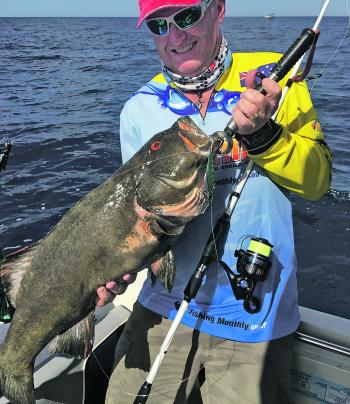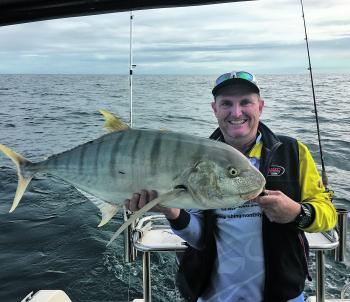June is when the cool westerlies start, and the offshore bug hits the region. We were lucky in May with some great weather, which gave us a few opportunities to get offshore.
It is amazing to see the amount of big boats in Bundaberg, and when the forecast is for variable winds the boat ramp at Burnett Heads is full, even on a weekday. The lighter winds in June will mean the smaller boats can get out there as well, and hopefully get some good fish from the inner reefs.
Mackerel will slow down over the coming months, but acres of tuna will make up for the lack of mackerel. We can expect a mixture of mac and bluefin tuna, with a few yellowfin mixed in, which will make great sashimi. You can mostly catch tuna casting high speed metal slugs. Slugs also work well on mackerel and other pelagics. On recent trips I have caught school, shark and Spanish mackerel ripping up a slug from the bottom at high speed.
The Burnett River has been yielding really big whiting in the town reach, mostly on fresh green prawns but also live yabbies, if you can get them.
Flathead are showing up in pretty good numbers for those trolling smaller deep diving lures around the sand bars. The grunter, which had earlier been in big numbers, have slowed down and their average size has dropped. They’re still around though.
Off the beaches, anglers are picking up plenty of dart out the front of Coonar. We catch them on pipis, and the kids love it. You can also get a few flathead and big bream at the mouths of the creeks. As winter approaches the water gets clearer, and the fish move to the mouths.
Years ago, offshore fishing was all about heavy outfits, big sinkers and multiple hooks. Now we are seeing lighter outfits with jigs attached, and even the bait fishing rigs are lighter, with chemically sharpened hooks and long, lighter leaders. With fishing pressure getting higher, you’ll find that scaling down will see your catches improve. I have had a few trips offshore of late, and my number one outfit has been a 6kg spin rod with a 6000 size reel loaded with 30lb braid and topped off with 50lb leader. I use this rig for jigging and casting. It is very versatile and has handled just about everything I have thrown a lure at.
On a recent trip I alternated between my old go-to, the 40g Halco Twisty and 60g, 4” blade I got out of a drop bin at my local tackle shop for $7.95. We were fishing the Warragoes, which is around 40 miles north of Bundaberg, and the bottom ranges between 60ft and 130ft. I drifted with my fishing partner, who was fishing bait. Over the deeper water I would cast the Twisty ahead of the boat, let it sink and then jig it up before letting it flutter back to the bottom. This technique imitates a dying fish, and the flutter of the Twisty flashes and attracts pretty much every predator there is. I put some very nice parrot, trout, hussar, cod and red-throat emperor in the esky.
When fishing the deeper water I would switch to the heavier blade and again cast away from the boat, letting the blade sink all the way down. I then varied my retrieve from hops up off the bottom to just a quick stop-start retrieve just above the bottom. This technique had the coral trout fired up, but I also caught cod, parrot and of course the mackerel just loved it as well.
My mate prefers to fish bait, and on that trip he used mostly fresh pilchard and cuttlefish heads. The bait certainly worked, and he caught some quality specimens, but he was constantly pestered by undersized fish. Most of the catch that made it to the esky was caught on lures, which tend to eliminate the smaller pesky fish. So if you’re going to take advantage of our winter months offshore and want to try something different, try doing some luring.
Reads: 2003
A very nice coral trout that just couldn’t resist a blade.

Golden trevally are great fun on light spin tackle. This one ate a jigged Twisty.




